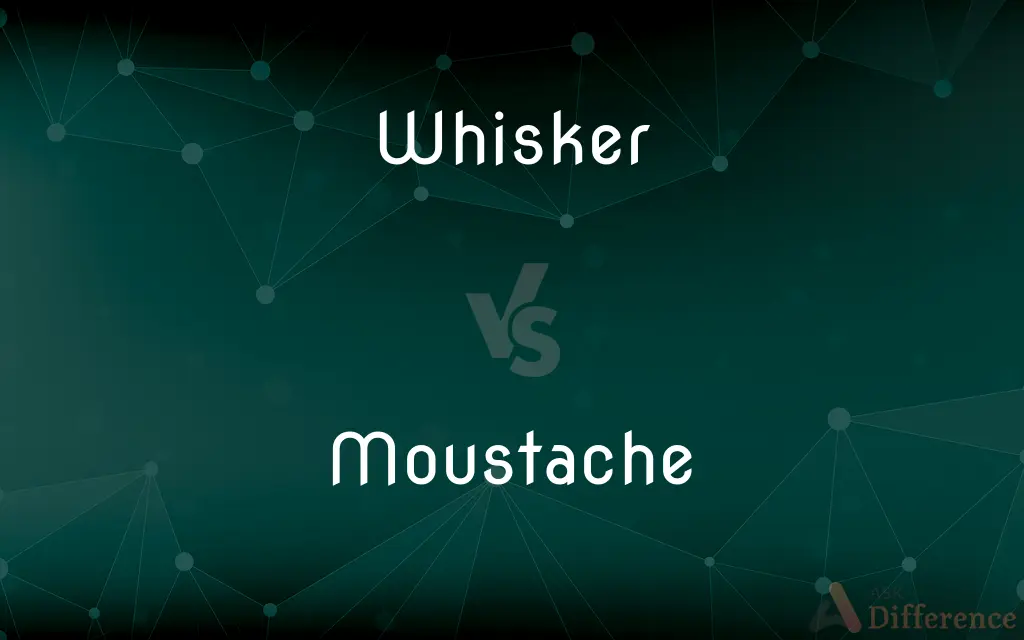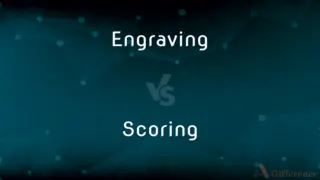Whisker vs. Moustache — What's the Difference?
By Urooj Arif & Fiza Rafique — Updated on April 15, 2024
Whiskers are tactile hair structures on animals, aiding in navigation and sensation, while a moustache is facial hair grown above the human upper lip primarily for aesthetic purposes.

Difference Between Whisker and Moustache
Table of Contents
ADVERTISEMENT
Key Differences
Whiskers function as sensory tools in animals, providing critical information about their immediate surroundings through vibrations and air currents. These tactile hairs are highly sensitive and can detect changes in their environment, aiding in navigation and spatial awareness. On the other hand, a moustache is typically grown for aesthetic reasons, contributing to a person's facial appearance and style. It has no sensory function and varies widely in shape and size depending on personal grooming choices and cultural influences.
In terms of biology, whiskers are also known as vibrissae and are deeply embedded in the animal's skin, connected to the nervous system, enhancing their sensory capabilities. Whereas a moustache is simply part of the human facial hair that grows on the upper lip and does not have any enhanced sensory connections or functions. It can be trimmed, styled, or shaved entirely according to personal or societal fashion norms.
Animals such as cats, dogs, and rodents rely on their whiskers to assess the size of openings, detect nearby objects, and even sense prey movements. These hairs are crucial for survival in many species, providing spatial data and helping avoid predators. Moustaches, however, often serve as symbols of masculinity or maturity in various cultures, and they can be a key component of identity and expression, with no direct survival benefit.
Whiskers are present in both genders of suitable animal species and are not subject to the same kind of cultural interpretation and manipulation that human moustaches are. In contrast, the moustache is typically a male facial hair feature and is often influenced by fashion, religious beliefs, or social status, with its presence and style varying significantly across different societies.
Maintenance and grooming also differentiate whiskers from moustaches. Animal whiskers require no human intervention and are naturally maintained by the animal through regular activities. Moustaches, however, require regular grooming, trimming, and care to maintain a desired appearance, reflecting personal hygiene and grooming habits.
ADVERTISEMENT
Comparison Chart
Function
Sensory, aiding in navigation and environment detection
Aesthetic, contributing to facial style
Connection to Nervous System
Yes, connects to enhance sensory perception
No, normal facial hair without enhanced senses
Cultural Significance
None, universally present in certain animals
Varies, influenced by cultural and personal style
Gender Specificity
Present in both genders of certain animals
Primarily male in humans
Maintenance
Naturally maintained without human intervention
Requires grooming and care
Compare with Definitions
Whisker
A long, projecting hair or bristle growing from the face or snout of many mammals.
The cat's whiskers twitched as it sensed movement.
Moustache
A mark or part of a design resembling a moustache.
The logo featured a quirky, stylized moustache.
Whisker
(Nautical) A wire or rope used to brace or extend the force of sails.
The crew adjusted the whiskers to stabilize the sailboat in the strong winds.
Moustache
A symbol of maturity and masculinity in many cultures.
Growing a moustache is a rite of passage in some cultures.
Whisker
Any hair-like sensor used for touch or detecting movements.
Robots sometimes use whisker-like sensors to navigate spaces.
Moustache
Associated with particular historical figures or stereotypes.
The actor was chosen for his striking resemblance and thick moustache, akin to the historical figure he portrayed.
Whisker
(Informal) Something resembling a whisker, especially in thinness or delicacy.
The new phone is as thin as a whisker.
Moustache
Facial hair grown and left to extend from the upper lip; often styled in various shapes.
He groomed his moustache to twirl at the ends.
Whisker
(Engineering) Fine filaments used in sensors or material testing.
The engineering lab uses carbon whiskers for material strength tests.
Moustache
A feature often altered during costume events or competitions.
For the competition, he waxed his moustache into an elaborate shape.
Whisker
Whiskers The hair on a man's cheeks and chin.
Moustache
A moustache (UK: ; American English: mustache, ) is a strip of facial hair grown above the upper lip. Moustaches have been worn in various styles throughout history.
Whisker
A single hair of a beard or mustache.
Moustache
Variant of mustache.
Whisker
One of the long stiff tactile bristles or hairs that grow near the mouth and elsewhere on the head of most mammals; a vibrissa.
Moustache
A growth of facial hair between the nose and the upper lip.
Whisker
(Informal) A narrow margin; a hairsbreadth
The candidate lost the election by a whisker.
Moustache
Mustache.
Whisker
(Nautical) One of two spars or booms projecting from the side of a bowsprit for spreading the jib or flying-jib guys.
Moustache
An unshaved growth of hair on the upper lip;
He looked younger after he shaved off his mustache
Whisker
(Chemistry) An extremely fine filamentary crystal with extraordinary tensile strength and unusual electrical or surface properties.
Whisker
That part of the beard which grows upon the sides of the face, usually of the male, or upon the chin, or upon both.
Whisker
A hair of the beard.
Whisker
One of the long, projecting hairs growing at the sides of the mouth of a cat, or other animal.
Whisker
(colloquial) The (very small) distance between two things.
It missed falling on your foot by a whisker.
Whisker
(nautical) Spreaders from the bows to spread the bowsprit shrouds.
Whisker
(statistics) A graphic element that shows the maxima and minima in a box plot.
Whisker
One who, or that which, whisks, or moves with a quick, sweeping motion.
Whisker
(metallurgy) A small tendril that forms on metal.
Whisker
One who, or that which, whisks, or moves with a quick, sweeping motion.
Whisker
Formerly, the hair of the upper lip; a mustache; - usually in the plural.
Hoary whiskers and a forky beard.
Whisker
That part of the beard which grows upon the sides of the face, or upon the chin, or upon both; as, side whiskers; chin whiskers.
Whisker
A hair of the beard.
Whisker
One of the long, projecting hairs growing at the sides of the mouth of a cat, or other animal.
Whisker
Iron rods extending on either side of the bowsprit, to spread, or guy out, the stays, etc.
Whisker
A very small distance or space;
They escaped by a hair's-breadth
They lost the election by a whisker
Whisker
A long stiff hair growing from the snout or brow of most mammals as e.g. a cat
Whisker
Furnish with whiskers;
A whiskered jersey
Common Curiosities
What is the primary function of whiskers on animals?
Whiskers serve as sensory tools that help animals navigate and sense their environment.
Are whiskers ever removed from animals?
Generally, whiskers should not be removed as they are crucial for the animal's spatial awareness and safety.
Can women grow a moustache?
Yes, women can grow moustaches, though it's less common and often influenced by genetic or hormonal factors.
Do whiskers grow back if cut?
Yes, animal whiskers do grow back if they are cut or fall out naturally.
Can trimming whiskers harm an animal?
Trimming an animal's whiskers can cause disorientation and stress, as they lose a key sensory tool.
How often should a moustache be trimmed?
The frequency of trimming a moustache varies by personal preference and style, typically ranging from once a week to every few days.
What cultural significance does a moustache have?
Moustaches can signify masculinity, maturity, and are sometimes associated with religious or cultural identities.
What are some common styles of moustaches?
Common styles include the chevron, handlebar, and pencil moustache.
How do whiskers aid in an animal's survival?
Whiskers help animals detect and navigate their surroundings, crucial for avoiding predators and catching prey.
Do all animals with whiskers use them for navigation?
While most do, the specific function can vary slightly based on the animal's habitat and lifestyle.
Why don't humans have whiskers like cats or dogs?
Humans have evolved differently and do not require whiskers for sensory navigation as some animals do.
Is it fashionable for women to have moustaches?
In most cultures, it is not typically fashionable for women to grow moustaches, but perceptions are changing with greater acceptance of diverse beauty standards.
Are there competitions for moustache styling?
Yes, there are moustache competitions where participants showcase creatively styled moustaches.
What determines the style of a moustache?
Moustache style is determined by personal choice, influenced by cultural norms, and sometimes the natural growth pattern of the hair.
What is the difference between a beard and a moustache?
A beard involves facial hair on the chin and cheeks, while a moustache is specifically the hair that grows on the upper lip.
Share Your Discovery

Previous Comparison
Aramaic vs. Arabic
Next Comparison
Engraving vs. ScoringAuthor Spotlight
Written by
Urooj ArifUrooj is a skilled content writer at Ask Difference, known for her exceptional ability to simplify complex topics into engaging and informative content. With a passion for research and a flair for clear, concise writing, she consistently delivers articles that resonate with our diverse audience.
Co-written by
Fiza RafiqueFiza Rafique is a skilled content writer at AskDifference.com, where she meticulously refines and enhances written pieces. Drawing from her vast editorial expertise, Fiza ensures clarity, accuracy, and precision in every article. Passionate about language, she continually seeks to elevate the quality of content for readers worldwide.















































